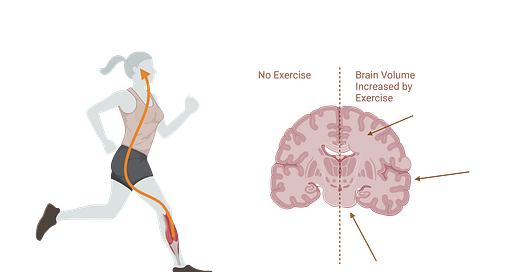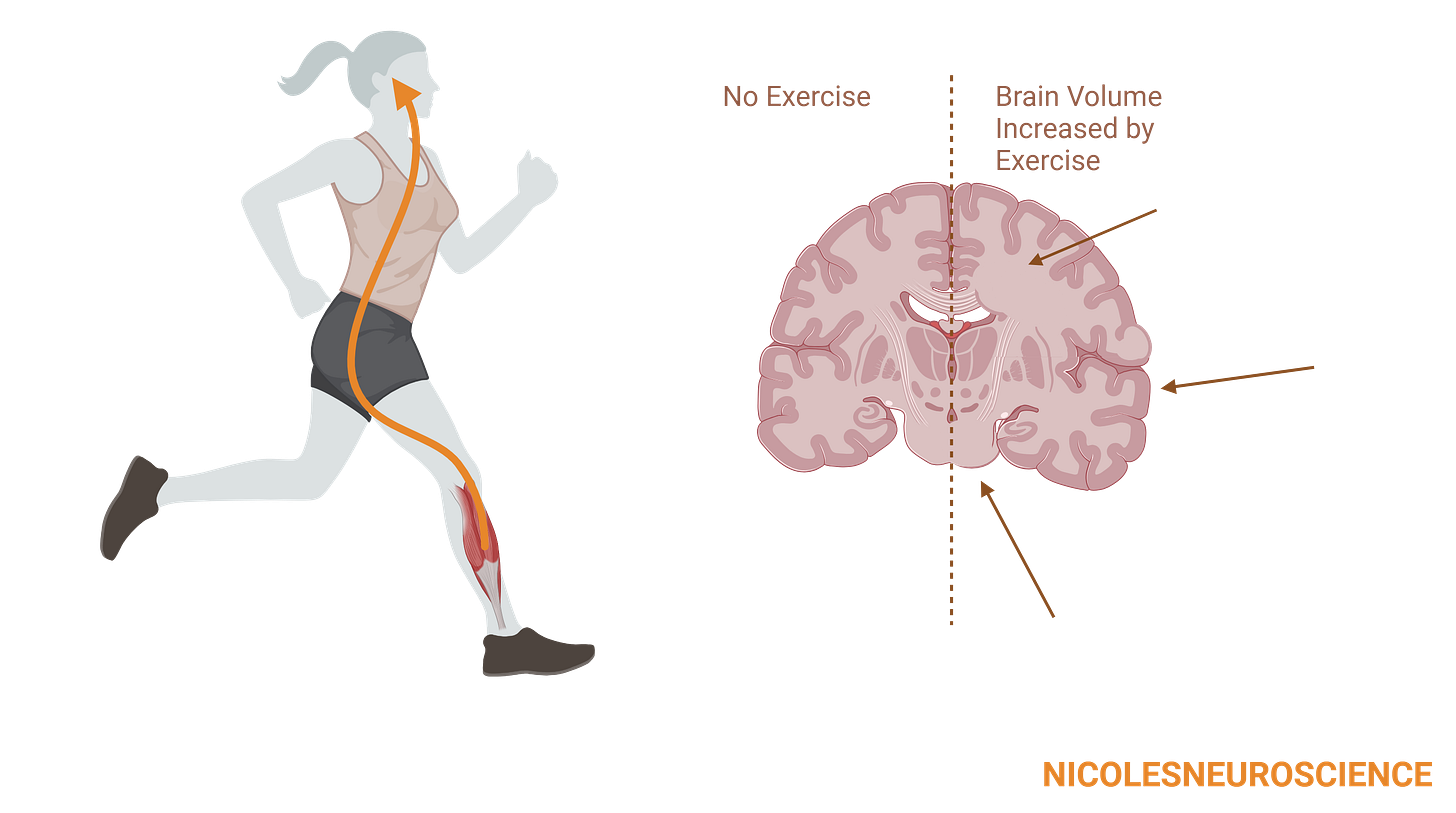Hey Brainiacs,
Welcome to this week's newsletter! Let’s explore what the muscle-brain axis is and how exercise improves your brain health.
The Muscle-Brain Axis
The muscle-brain axis is a term to describe the intricate connection between your skeletal muscle cells and your brain cells. It is a useful way to visualize how exercise has such far-reaching impacts, including those on your brain.
We know that exercise is critical for brain health at all ages, having both positive short-term and long-term impacts. People who participate in physical activity show healthier aging trajectories, meaning they have fewer declines in health and functioning as they get older1. And a history of long-term physical activity, even in the form of walking, was associated with better cognitive performance in old age2. This is true for non-healthy brains as well.
A randomized clinical trial showed that people with Alzheimer’s disease have improvements in cognition after participating in an exercise program3. This effect is partly explained by the fact that exercise increases brain volume4. Importantly, only aerobic exercise increases brain volume, but I’ll get to that later. For now, we know that aerobic exercise increases brain volume, leading to positive effects on cognition. But there’s more! These studies have looked at the effects of both long-term exercise1,2 and short-term exercise3,4 and found they are both useful. This means wherever you are in life starting exercise will help you right now and in your future!
Why do I care that it’s a randomized clinical trial?
We’re going to briefly delve into the theory behind scientific methods. This is important when you’re trying to understand if an intervention actually works.
A randomized controlled trial (RCT) is the gold standard for proving an intervention works. An RCT will have at least two groups of participants. One group will be given the intervention, and one group will be given a placebo (a fake, essentially). Participants are randomly assigned to one of the two groups. This is the crucial bit: random. If the participants are not randomly assigned to groups, we cannot be sure it is the intervention that worked or didn’t work. Perhaps everyone who got the drug was also a smoker, and so they were bound to have worse outcomes. Or perhaps everyone who got the intervention was already in perfect health. This is a long way of saying if you want to check something works, make sure you can find a randomized controlled trial to prove it.
Now we know that exercise can help our overall brain health, so let’s talk about exercise and mood. In ‘healthy’ people and people with different mental illnesses, both long-term exercise training and short bouts of exercise improve mood. In particular, patients with panic disorder observed reduced anxiety and reduced panic attack frequency and intensity following exercise7. In ‘healthy’ patients, vigour, fatigue, and mood all improved8 after only 10 minutes of exercise.
‘But how?’, I hear you ask. Excellent question, reader. We are still learning precisely how exercise exerts these effects, but so far, along with mitochondrial effects (check out my past newsletter) we know that different myokines (or muscle proteins) are important. I’ll be discussing two important myokines here: brain-derived neurotrophic factor (BDNF) and insulin-like growth factor-1 (IGF-1)9.
Zone 2 Aerobic Exercise
Zone 2 aerobic training is any exercise that is done at 60-70% of your maximum heart rate. Think of an easy run where you can still talk to a friend. ‘Aerobic’ describes a process that uses oxygen as energy, and during this type of low-intensity exercise, you use oxygen as your primary energy source (5). Aerobic exercise therefore trains your mitochondria, the guys responsible for synthesizing that energy. Your mitochondria are critical for healthy cell functioning, and mitochondrial dysfunction is linked to many health problems, so training them to function well is important (6). I like to highlight the positive effects of Zone 2 training because it doesn’t feel as intimidating as weight lifting, and it has equally important benefits!
Myokines – BDNF and IGF-1
Myokines, or muscle proteins, are released when muscles mechanistically contract and relax repeatedly, which happens during exercise. They have a wide range of functions, including improving anxiety, protecting neurons, and maintaining synaptic integrity. The two I’ll be focusing on today are BDNF and IGF-1. We know that when IGF-1 is released from muscles it can cross the protective barrier surrounding the brain to communicate with it directly9. It remains unclear if BDNF can do the same, but we think that if it cannot, other myokines cross the barrier and encourage the brain to produce more BDNF itself10.
BDNF and IGF-1 play a critical role in brain cell survival, growth, and plasticity9. BDNF is a molecule that binds to its receptor, TrkB, like a key fitting into a lock11. IGF-1 is the key for the IGF-1 receptor12. When both of these ‘locks’ are opened, they trigger different signalling pathways, like PI3K-Akt, which causes neurons to enter a pro-survival state and grow! In particular, the BDNF signalling pathways can activate a protein called CREB, which encourages brain cell plasticity and stress resistance11. Regardless of the funny protein names, I hope it is clear that both of these myokines released by exercise are important in brain cell survival, growth, and plasticity. It is through these mechanisms that exercise improves learning and memory and exerts anti-depressant effects.
Exercise and Learning – IGF-1 and BDNF
Exercise causes the release of BDNF and IGF-1, which leads to improvements in learning, memory, and mood. These myokines have overlapping signalling pathways, and both majorly act on the hippocampus, a brain region crucial for learning and memory13.
Remember how earlier we had a little chat about scientific methods to prove interventions work? Well, in animals, a strong way to prove something is necessary for something else is by removing it. In animals, we see exercise causes a strong and long-lasting increase of BDNF in the hippocampus. We also see exercise improves their memory. So, what happens if we block BDNF after exercise? We no longer see an improvement in memory14. Acquiring new memories and remembering old memories are both blocked15,16. This is explained by the fact that blocking BDNF blocks the production of new proteins necessary for plasticity and plasticity is necessary for learning and memory15,16. So, we conclude that BDNF is necessary for these exercise-dependent improvements in learning and memory.
Let’s apply the same logic to IGF-1. Exercise causes increased IGF-1 in the hippocampus17,18. It also improves learning and memory. So, if we block IGF-1 signalling after exercise, what happens? You probably guessed it; we don’t get improved memory anymore18. Interestingly though, we can still acquire new memories18. This was not possible when BDNF was blocked. Therefore, we think that BDNF is the primary driver of exercise-induced synaptic plasticity required for acquiring new memories, while both BDNF and IGF-1 are important for maintaining and improving pre-existing memories.
Exercise and Mood – IGF-1 and BDNF
How is it that exercise improves learning, memory, AND mood? Well, BDNF, which is produced by exercise and is important for learning and memory, is also important in depression! Lower BDNF levels are associated with a higher risk of depression. And the region where BDNF and IGF-1 increase most in response to exercise, the hippocampus, is also affected in depression. Thus, increasing BDNF and IGF-1 in this dysfunctional area may help restore normal functioning. Just like how we removed IGF-1 and BDNF signalling after exercise to see if they were important, we can also add BDNF and IGF-1 without exercise to see if it’s important. And it is! Directly injecting BDNF or IGF-1 into the brain causes anti-depressant-like effects in animals19,20. But we haven’t quite known why. Recently, emerging evidence suggests that much like how plasticity is important for learning and memory, plasticity may also be behind these anti-depressant effects. BDNF and IGF-1 may help to open up old unhealthy brain networks and forge new ones.
So together, let’s rewrite the reason for exercise. It isn’t for appearance, or to compensate for eating a slice of cake. It’s to help your brain!
Until next week,
Nicole x
P.S. Please leave a comment with topics you’d like to see in future newsletters!
References
https://ijbnpa.biomedcentral.com/articles/10.1186/s12966-020-00995-8
https://www.frontiersin.org/journals/neuroscience/articles/10.3389/fnins.2021.662242/full
https://www.sciencedirect.com/science/article/abs/pii/S0166223607001786?via%3Dihub
https://www.sciencedirect.com/science/article/pii/S0166223602021434
https://onlinelibrary.wiley.com/doi/epdf/10.1111/j.1460-9568.2004.03720.x?src=getftr
https://www.sciencedirect.com/science/article/pii/S0006899305015970
https://www.sciencedirect.com/science/article/pii/S0306452206003228
https://www.sciencedirect.com/science/article/pii/S0006899305000545





